Description
Also, check out our other books and videos – Click here
Covers the following cameras:
Nikon D5, D4, D4s
Nikon D850, D800, D810,
Nikon D750, D780
NIkon D600, D610
Nikon D500
Nikon D7500, D7200, D7100
Nikon D5xxx series, D3xxx series
Nikon Z series (Z6/7)
Format: PDF e-book (v 1.0.2)
Delivery: Instant download
Note that the vast majority of the information in this book also applies to older Nikon bodies as well (D7000, D3, D300, D700, etc). However, their specific control layouts, menu options and external switch locations are not referenced in the book. (This also applies to the Df.). Additionally, much of the information in this book can apply to any camera, regardless of the brand, it’s just that the specific examples, customizations, and usage lessons are geared for Nikon.
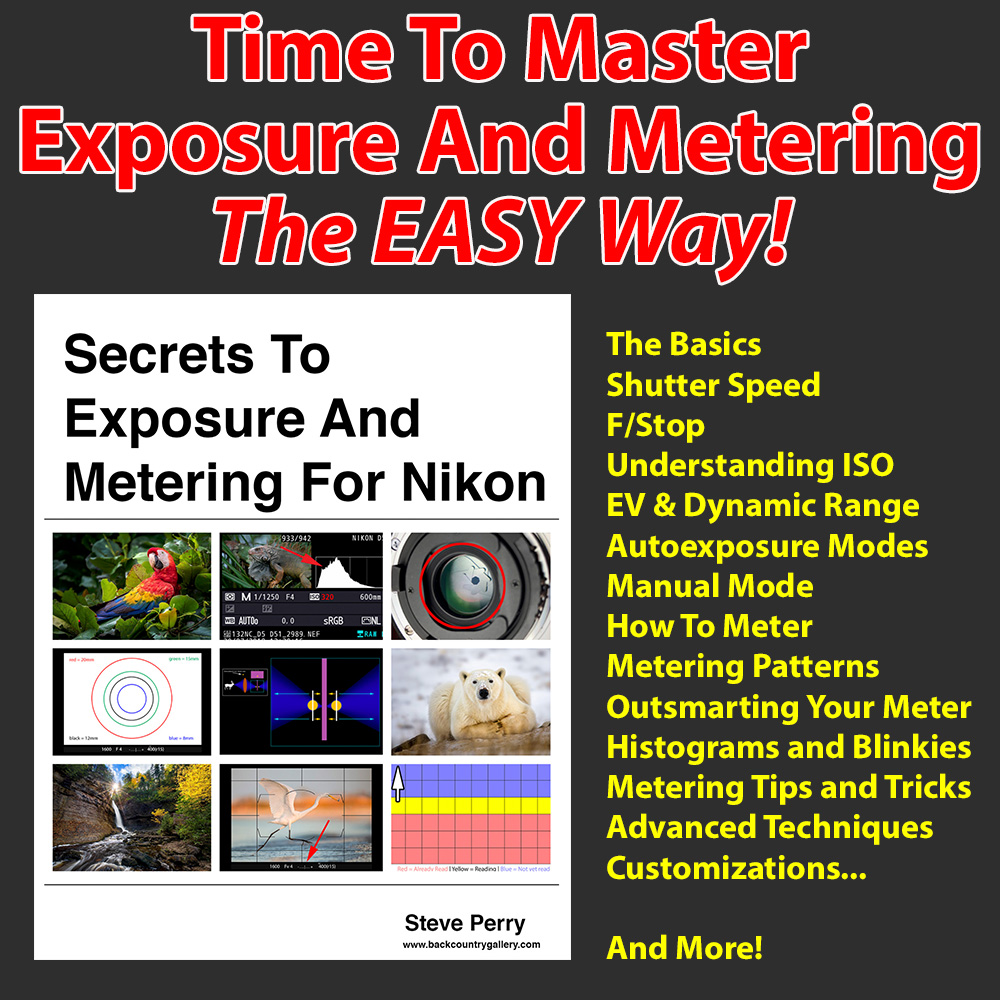

Master Your Exposure And Metering Controls!
Exposure and metering – no other pair of photographic tools has the potential to make or break your images like these two! And yet, completely leveraging them to create phenomenal imagery is one aspect of photography that continually eludes many photographers.
So many of us go through our photographic life with an incomplete understanding of things like shutter speed, F/Stop, ISO, metering, exposure modes, etc. Well, not anymore! This book fills completely in the gaps.
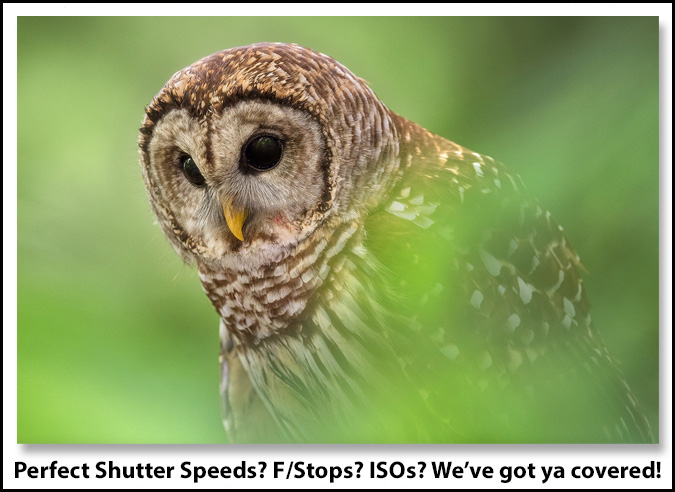
In this e-book, we tackle both exposure and metering – to the extreme! Just wait till you dive into the 670 + pages jam-packed with information, illustrations, photos, and examples that directly translate to killer images on your memory card each and every time you head out.

Chapter after chapter we peel away the mystery, myths, and enigmas surrounding exposure and metering – replacing the confusion with the rock-solid information you demand. Plus, the techniques described in this e-book are fully field tested and you can see the real-world results firsthand throughout the pages.
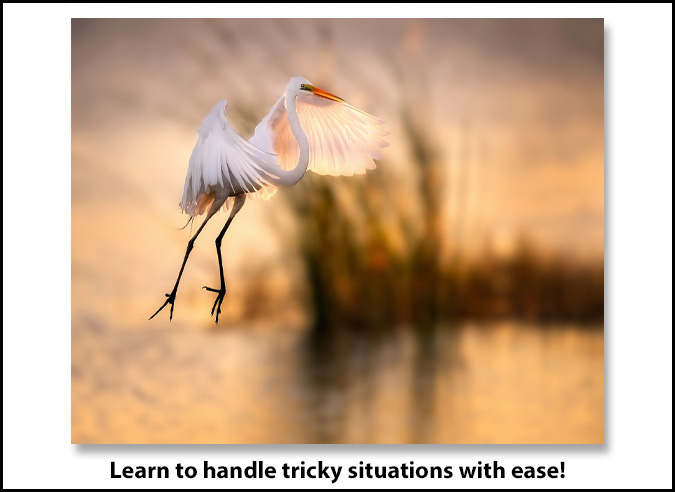
As for skill level, this e-book is written for every photographer. It covers everything from the very basics to advanced exposure and metering techniques, fully explaining everything in a non-technical, easy going style that makes comprehension both painless and fun. (I’ve been known to add a little humor here and there, what can I say?) The book takes the technical jargon and breaks it down into easy to digest bites that anyone can understand. No matter what your current skill level – beginner, intermediate, or even advanced – this book has something waiting for you to discover between the virtual covers!
Two Books In One!
This e-book is actually like getting two books in one!
In part one of the book, we carefully examine each aspect of exposure – shutter speed, F/Stop, and ISO. We thoroughly look at ways to leverage each to our creative advantage and how to prioritize one over the other. We explore how to use the controls at your fingertips to consistently and effortlessly create wall-hangers from the images in your mind’s eye. We sweep the myths and misinformation aside and learn rock-solid, field-tested advice.
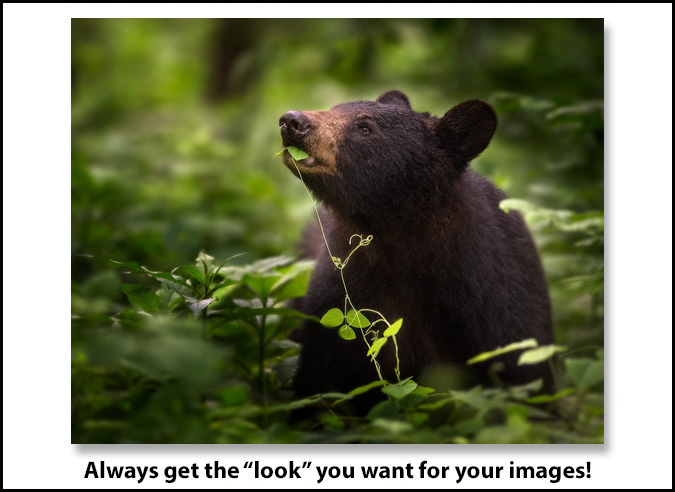
Unlike many books, this doesn’t just gloss over what shutter speed, F/Stop, and ISO do – this digs deep to help you find new and creative ways to leverage the exposure controls at your disposal.
In part two of the book, we start our exploration by tackling all the various autoexposure modes available in your camera – and when and why to use them. We also discover just how easy shooting in full Manual mode really is when you understand how it all works! If you’ve ever wanted to learn to drive the camera in Manual mode, this book will get you there via Easy Street!
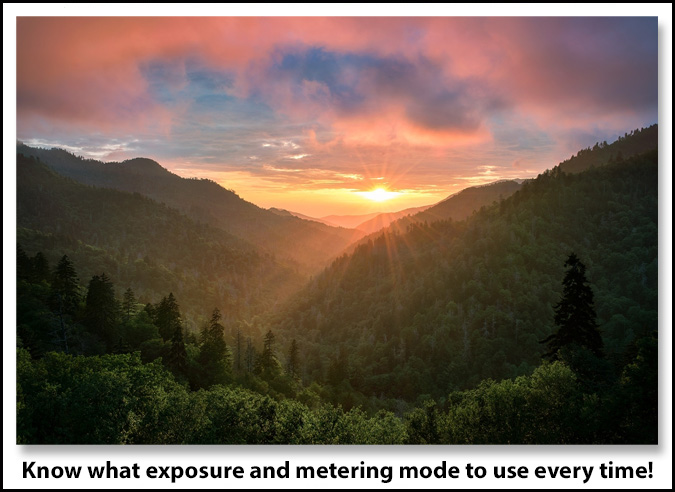
In addition, part two also explains how the various metering patterns work – everything from Center-weighted, to Spot, to Matrix, to Highlight-weighted metering are thoroughly covered. We explore how each thinks, and, more importantly, when and why to use each.
Of course, we also dive deep into topics like Exposure Compensation, using AE-L, tweaking your exposure in Manual mode, how to use Histograms, how to use Blinkies, and tons of tips and tricks for getting the perfect exposure each and every time.
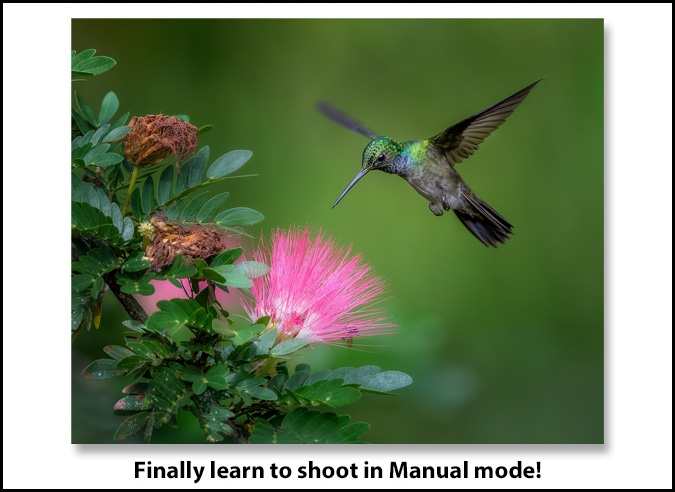
And, naturally, throughout the process we talk about how to juggle shutter speed, F/Stop and ISO to create the type of images you want on your memory card. It’s not just enough to get a “nice exposure” – you also need to know how to use those controls to put jaw-dropping images on your card!
We even look at advanced exposure techniques like ISO Invariance, ETTR, HDR, and so much more – there’s even a bonus chapter for night shooting!
BONUS!
In addition to the Exposure and Metering book, you also receive an additional 60 page supplementcovering deep focus techniques! This e-book shows you exactly how to achieve super-deep depth of field without resorting to small F/stops – A must read – and it’s yours FREE with your purchase!
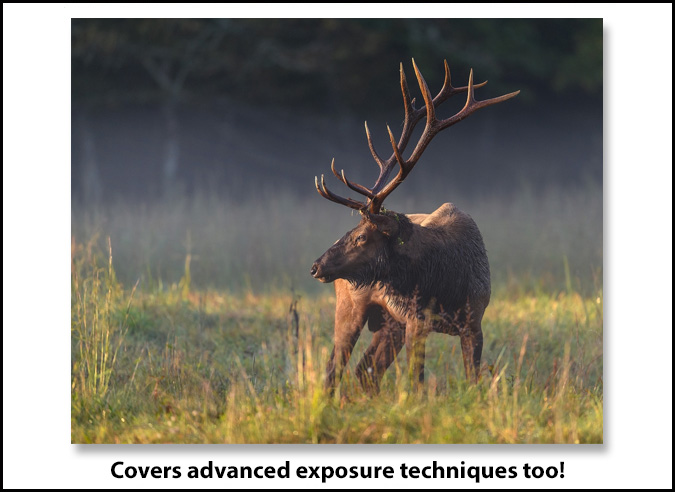
Wanna see list of everything we cover? Taker a deep breath and we’ll look at the highlights chapter by chapter…

CH 1 – The Basics
- Understanding the absolute basics
- The difference between Shutter Speed, F/Stop, ISO
- A super-easy analogy to understand what exposure controls do
- Discover how exposure controls work together
- Unwrap the mysteries of reciprocity
- How “Stops” work with Shutter Speed, F/Stop and ISO
CH 2 – Shutter Speed
- Discover what shutter speed is really all about
- How your shutter works
- Learn about dangers of rolling shutter
- The real reason motion blur happens
- Discover the amazing ways shutter speed changes a photo
- The shocking truth about shutter speed, rate of travel, and distance
- Leveraging speed and distance to your advantage
- Why pixel density is critical when choosing a shutter speed
- Why you need more shutter speed / support with high MP cameras
- Discover the smartest way to choose the right shutter speed to stop action
- Beat camera motion for sharp images
- The new hand-holding shutter speeds
- The secrets to hand-holding a lens for the sharpest results
- Know when to use VR and when to turn it off
- The surprising way burst shooting helps you get sharp images
- Discover the best type of camera support – tripods, monopods, bean bags etc.
- Secrets to showing motion in your images
- How to choose the best shutter speed to show motion
- Understand how neutral density (ND) filter work
- The key to great panning
- Tricks for showing motion with your panning
CH 3 – Aperture And F/Stop
- Discover how your lens aperture works
- The critical difference between mechanical and electronic apertures
- How depth of field really works
- Unlock the mysteries of depth of field distribution
- Discover how Circle Of Confusion works – the easy way
- Learn impact of F/stop on depth of field
- Secrets to how distance influences depth of field – and how to take advantage of it
- Why focal length doesn’t affect depth of field the way you think
- The shocking thing everyone gets wrong about focal length and depth of field
- Why sensor size doesn’t affect depth of field
- Discover the real reason a crop camera seems to have more depth of field than full frame
- How to leverage crop and full frame sensor size to your advantage
- The unexpected negative side-effect of cropping your full frame sensor
- The secrets to choosing the right depth of field every time
- The key to using selective focus as part of your composition
- How to really annihilate terrible backgrounds
- Tips for keeping two subjects in focus with shallow depth of field
- Why mid-range depth of field is the go-to choice for so many images
- Learn to tell stories with mid-range depth of field
- Why mid-range depth of field gives you maximum sharpness
- How to leverage depth of field for action
- Lean when deep depth of field is the best choice
- How to get deep depth of field without small F/stops
- The terrible truth about diffraction
CH 4 – Understanding ISO
- Discover why ISO isn’t really an exposure control
- Learn why your camera only has one “real” ISO
- How your sensor collects light
- Secrets to how ISO really works
- How light from your sensor turns into an image file
- What signal to noise ratio is and why it’s critical you know
- Learn what really causes noise (and no, it’s NOT ISO!)
- Why shot noise is your #1 enemy
- Discover the real reason why noise increases as light levels fall
- Learn what read noise is and how it affects your images
- Discover the reason ISO doesn’t cause noise – and what the real culprit is
- The truth about why high ISO shots typically have more noise than low ISO shots
CH – 5 Advanced Exposure Considerations
- All about EV (Exposure Value)
- Learn the brightness differences between various EV levels
- How to use EV to determine exposure
- Discover all you need to know about dynamic range
- How to discover the dynamic range of your sensor
- The critical way ISO affects dynamic range and why you MUST know how it works
- Example photos of high and low dynamic range shots
- Tricks for maximizing dynamic range
- Why shadows are often too noisy – and how to prevent it
- Why cropping your image lowers photograph dynamic range
- Discover how bit depth works
- Learn which bit depth is right for you (12 or 14)
- How dynamic range and bit depth work together
CH – 6 Raw vs. Jpeg
- Which is better – Jpeg or RAW
- The advantages to shooting Jpeg
- Discover the even better reasons to shoot RAW
- See how RAW can make an incredible impact on your image output
- Why a RAW file has better dynamic range
- Compare RAW and Jpegs side by side to see the RAW advantage (dramatic!)
- How to make RAW easier and faster to post-process
- The easy way to make Jpegs from your RAW files
- Discover when and how to use the High ISO NR option on your menus
- Learn the best image quality settings
- Unlock the best RAW compression options

CH 7 – Autoexposure Modes
- Discover why Manual mode isn’t always the answer
- Why you MUST avoid “Idiot” modes!
- Unlock the secrets to effective use of Auto ISO
- Learn to set up Auto ISO – the correct way
- The two best guidelines for setting Auto ISO max sensitivity
- The FATAL mistake everyone makes with Auto ISO max shutter speeds
- The key to using Program mode successfully
- Learn the weird things that happen with P + Auto ISO
- How Shutter Priority works
- The Shutter Priority mistake everyone makes
- Why Shutter Priority and Auto ISO are a perfect match
- Discover why Aperture Priority is the most popular autoexposure mode
- How Aperture Priority makes it easy to juggle exposure controls
- The secret reason way Aperture Priority is the best way to get max shutter speed
- The key to using Auto ISO and Aperture Priority
- Discover the power of Manual + Auto ISO
- The surprising reason why M + Auto ISO is the autoexposure mode I use for action
- See real-world examples of why M+Auto ISO smokes all the other autoexposure modes
- Watch M + Auto ISO go head-to-head with the rest of the exposure mode dial
CH 8 – Full Manual Mode
- The critical mistake people make when then turn to Manual mode
- Why shooting in full Manual mode is WAY easier than you think
- Step-by-step instructions for shooting in full Manual mode
- How to adjust your exposure in full Manual mode
- Discover the best way to determine your Manual exposure
- Learn how to prioritize F/stop, Shutter Speed, and ISO
- Check out an example of Manual mode in action
- How to tell you’re day is done
- Why Manual mode isn’t a cure for poor light
CH 9 – Metering Basics
- What metering is and how it works
- The challenges of reflective metering
- All about middle-tone and why your meter loves it
- Why your meter underexposes scenes with bright tonalities
- Examples of what happens when your meter is faced with dark tones
- How to correct your exposure when faced with the wrong exposure
- Discover how to see like your meter
- Why your meter gets fooled sometimes
- How metering and AF play together
CH 10 – Metering Patterns
- How to change metering modes
- All about Center-weighted metering
- Learn how Center-weighted metering evaluates a scene
- How Center-weighted metering “weighs” the exposure
- Discover the best situations for Center-weighted metering
- How to customize Center-weighted metering for your needs
- Learn how Spot metering works
- Why Spot metering is both useful – and dangerous
- Learn where Spot metering takes its measurement
- How different AF modes affect Spot metering
- The HUGE mistake first-timers always make with Spot metering
- How poor Spot metering can destroy a perfectly good image
- The secret to using Spot metering effectively
- How to recognize situations where Spot metering will betray you
- Learn all about Matrix metering
- How to think like your Matrix meter
- Learn the times when Matrix metering will always miss the proper exposure
- Discover why Matrix metering is often the most reliable
- Using and turning on Face Detection with Matrix metering
- Unravel the mystery of Highlight-weighted metering
- How Highlight-weighted metering compares to Matrix for the same scene
- The secret to getting the most fromHighlight-weighted metering
- Find out if there really is a “best” metering pattern for you
- Learn how to customize a button to instantly switch metering modes
CH 11 – Outsmart Your Meter
- Discover the secret to effective exposure compensation
- How exposure compensation works
- Learn what exposure compensation adjusts in every autoexposure mode
- How to use exposure compensation to get a perfect exposure
- Why exposure compensation is often better than Manual exposure mode
- How Auto ISO works when exposure compensation is used
- Uncover the dangers of using exposure compensation
- How Autoexposure Lock (AE-L) works
- Why AE-L is a handy way to fix exposure problems
- How to setup AE-L on a programmable button
- Learn to use Manual Exposure to overcome metering errors
- The secret to knowing when to choose autoexposure or Manual mode
- The common scenario where Manual mode just destroys any autoexposure mode
Ch 12 – Histograms And Blinkies
- Discover how Histogram can help you get a perfect exposure
- Learn what a histogram is
- The easy way to read histograms
- How to use a histogram to determine if an image is over or under exposed
- Learn how histograms warn you of critical exposure issues
- How histograms help you prevent the worst exposure sin you can commit
- The dirty secret about histograms and RAW files
- How to set your camera to view histograms
- Learn to read a histogram with multiple examples
- Avoid common histogram reading mistakes
- All about blinkies
- Why blinkies are often a better, faster choice than histograms
- How to set your camera to show blinkies
- The reason I like blinkies better than histograms
CH 13 – Metering Tips And Tricks
- Discover how to use the “Sunny 16” rule
- Check out a handy chart for “Sunny 16” values at various F/stops and ISOs
- How to meter when there is no middle-tone
- Tips for metering any tonality and producing a successful exposure
- Why your hand is like a gray card with fingers
- The secrets to handling tricky situations that love to fool meters
- Handling mixed snow and subject conditions
- Discover the key to shooting properly exposed images in the fog
- The cool trick for perfect sunrise and sunset exposures
- Learn tips and tricks for handing backlight
- The secrets to successful silhouettes
- How to get backlit subjects that have detail
- The smartest way to expose backlit shots
- Four tips every backlight shooter must know
- All about the Active-D lighting “gimmick”
- How Active-D lighting really works
- Proof that shooting RAW will give you better results than Active-D lighting
- Learn all about bracketing
- Learn to manually bracket exposures
- How auto bracketing works
- Learn how to set your camera for auto bracketing
- The one critical thing you MUST do after auto bracketing
CH 14 – Advanced Exposure Techniques
- Discover exactly what ISO invariance is
- See examples and comparisons of normal ISO images and “ISO invariant” shots
- Learn why ISO invariance works
- How to test your camera’s ISO invariance
- Real-world examples of leveraging ISO invariance
- Using ISO invariance to shoot images that are “impossible” with a conventional exposure
- Why sometimes allowing the camera to underexpose is the smartest way to shoot
- Discover the truth behind the “lo” and “hi” ISO settings
- Unravel the mysteries of ETTR
- Why ETTR can sometimes help you get the most from your images
- How to use ETTR to get the maximum dynamic range from your sensor
- Learn to shoot ETTR
- Discover when to use ETTR and when to pass
- How to test your camera’s ETTR abilities
- Learn the truth about using ETTR at higher ISOs
- Discover how HDR can help you shoot beyond your camera’s capabilities
- How to shoot an HDR image set in the field
- How to create a final HDR image from your photos
- Discover how to create a tasteful HDR image
CH 15 – Customizing Your Metering System
- Unwrap all the exposure and metering customizations your camera offers
- Discover how to decide the best way to set your ISO and Exposure step value
- Learn how to set and use Easy Exposure Compensation
- Unlock the mystery of the Fine Tune Optional Exposure menu
- Why your standby timer can keep you from making critical exposure errors
- Finally get your camera to show you the current ISO in the viewfinder
- All about Easy ISO
- How Exposure Delay Mode can help you get tack-sharp images
- Why you should use Electronic Front Curtain Shutter – and how to set it up
- The cool trick you can do with your Move Record button and ISO
CH 16 – Bonus Chapter – Night Shooting Basics
- Tons of tips and techniques for night shooting
- Why full manual mode is your best friend at night
- Learn how to pick the best lens for nighttime photography
- When and how to use the Long Exposure Noise Reduction feature
- The surprising way vibration sneaks in during long exposures
- How to fight dew
- How to focus the camera in the dark
- Learn the easiest way to determine the best exposures
- Learn how to successfully photograph the moon
- The surprising reason why the moon is your nemesis at night for stars
- How to find “dark skies”
- The rookie mistake all night shooters commit
- How to use the “300”, “500”, and “600” rule
- How to shoot the Milky Way
- How to photograph star trails
- Why star trails are tricky to shoot with digital
- How to find the North Star
- Discover the easy way to shoot star trails with a locking cable release
- Learn how to use your camera’s intervalometer for longer sessions
Whew!
Yup, there is a massive amount of information here! In fact, we’re talking over 670 pages jam-packed with reliable, time-tested advice that I’ve been using in the field for years. Check out the sample pages below to get an idea of what’s in store. As you can see, hundreds of photos and illustrations to help drive the lessons home!
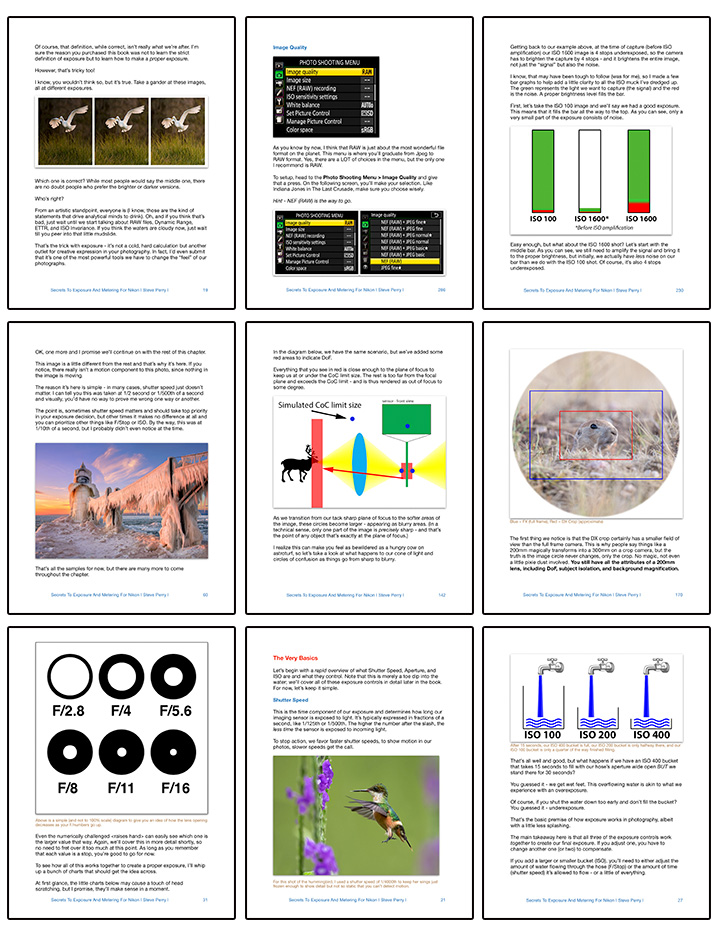

Finally, if you’re still on the fence, think of it this way…
So many times we spend countless hundreds or even thousands of dollars purchasing gear that we hope will help us create more powerful images.
The truth is, gear is only a small part of the equation. Amazing imagery comes from YOU – the person standing a few inches behind the viewfinder.
However, when offered an opportunity to improve the part of their photography that could generate a quantum leap in quality, people often hesitate. I know for a fact that my best images were due to hundreds, even thousands of hours spent studying educational materials, not because of the gear.
So, that brings us to price. I’ve tried to make this completely affordable for any photographer – just $22.97 and it’s an instant download.
That’s basically less than a lunch date for a product that could improve your photography exponentially. Heck, even if you only discover ONE new trick or technique that helps you create an amazing image, wouldn’t it be worth it?
Check it out, you could be enjoying this new e-book in just a few minutes.
So, order now and you’ll have the book in a matter of moments!
PS – I’m 100% confident you’ll love this e-book. If you’re not satisfied, let me know and I’ll give you your money back – nothing to lose by giving it a try!






cazul –
Excellent, easy understandable representation, easy and funny to read, covers really all aspects you might imagine. I alredy knew quite a lot about this stuff, but even for me it pointed up a couple (maybe 3 or 4) things i didn’t know before. Even one of them alone would have justified the price of $22!
Thanks a lot, Steve!
Chris Taylor (verified owner) –
Steve has a way of explaining things simply … yet going into the level of detail necessary to really ferret out all the nuances. For example, I had done some reading on “rolling shutter” and had gotten some recommendations which I could follow, but I didn’t REALLY understand what was going on. In “Secrets to Exposure and Metering For Nikon”, in four pages, Steve explained all the nuances about rolling shutter so that I now really do understand what the tradeoffs are and now I more intuitively know when to go with the mechanical shutter and when to go electronic. It is no longer “I choose xxx because someone on the Internet said that’s what I should choose”. Now it is “I choose xxx because Steve Perry explained what is really happening.”
His corny sense of humour always has me groaning :-), but his explanations are crystal clear!
Thanks, Steve. This is the second e-book I have bought from you and both are proving to have an incredible amount of detail, all very clearly explained. And that’s what we photographers need to up our game.
Eddy Laboy (verified owner) –
Wow! This e-book is jammed pack with every detail you can possibly look for on metering and exposure. I’m glad I encountered this e-book because there is no way I would’ve found all these answers all together in one source. Awesome, thanx. Please publish the paperback….
Thomas Otterbein (verified owner) –
It’s quite simple the best what is available.
Understandable explained and extremely helpful…
John Yesuraj (verified owner) –
Hi Steve,
I have been photographing as a hobby for a while now and despite my best efforts, right exposure has baffled me many a times.
After seeing some of your videos on Youtube, I purchased your Ebook few days back and I am hooked to it as a bestseller & reading it all over again to internalize it all. Probably the best purchase I have done so far. Thanks a lot for this incredibly easy to read book, with lots of practical tips.
Though too much similes were annoying to me frankly, the narration and the flow is awesome and has given me great confidence now. Soon planning for the next one on ‘ Nikon AF Systems’.
Thanks once again. It’s a great book.
Richard Leach (verified owner) –
I am an advanced amateur photographer. I have watched numerous videos and watched classes from various instructors. This is the first book to help me truly understand the capabilities of my camera. The information is clearly explained, and the humor keeps you mind focused. I have changed settings in my camera and looking forward to practicing what I have learned.
John Williams (verified owner) –
While I have been ‘doing photography’ for a number of years – this book has help me understand exposure and how to better use the options/tools our cameras provide us.
Excellent – strongly recommend
Victoria Austin (verified owner) –
Wow what a book! I’ve learnt so much reading this and put quite a few myths to bed. So much better than those ‘how to’ books, as Steve explains the ‘whys’ and provides examples and insights to back that up. So refreshing and hugely practical! As a dedicated Nikon DSLR user (after years of ‘film’ SLR using different makes back in the day), the Nikon-focus is so helpful, as I can immediately relate the tools, techniques and settings directly to my camera. Now onto putting what I’ve learnt (and understood) into practice 🙂
Kemble Widmer –
Wow. I’ve been at wildlife photography for 30 years and learned a ton from this book.
It’s an incredible value considering you can bookmark it, reference it, and re read it over and over again.
Steve’s style of writing and humor make it a joy to read.
Thank you Steve.